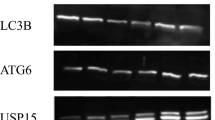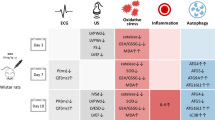Abstract
Doxorubicin (adriamycin) is an effective drug in the treatment of many malignancies. Its prolonged use is, however, limited by an irreversible, dose-dependent and progressive cardiomyopathy, which may become evident even years after completion of therapy. Data from rats and humans show that oxidative phosphorylation is impaired rapidly after acute doxorubicin-exposure. Such respiratory chain dysfunction is known to enhance the production of reactive oxygen species and may lead to quantitative and qualitative injury of mitochondrial DNA (mtDNA) and its encoded respiratory chain subunits. MtDNA depletion, mtDNA mutations and respiratory defects then accumulate with time also in the absence of continued anthracycline exposure. Chronic cardiotoxicity then manifests, when the bioenergetic capacity of the organelles is severely impaired. The mitochondrial damage in late-onset doxorubicin cardiomyopathy is heart specific and not found in skeletal muscle. DOXO-EMCH, a 6-maleimidocaproyl hydrazone derivative of doxorubicin has evolved from the search for less cardiotoxic anthracyclines. At equieffective antitumor doses, DOXO-EMCH has a substantially lower heart toxicity than free doxorubicin.



Similar content being viewed by others
References
Buzdar, A. U., Marcus, C., Smith, T. L., & Blumenschein, G. R. (1985). Early and delayed clinical cardiotoxicity of doxorubicin. Cancer, 55, 2761–2765.
Steinherz, L. J., Steinherz, P. G., Tan, C. T., Heller, G., & Murphy, M. L. (1991). Cardiac toxicity 4 to 20 years after completing anthracycline therapy. JAMA, 266, 1672–1677.
Minow, R. A., Benjamin, R. S., & Gottlieb, J. A. (1975). Adriamycin (NSC-123127) cardiomyopathy – an overview with determination of risk factors. Cancer Chemotheraphy Reports, 6, 195–201.
Ferrans, V. J. (1978). Overview of cardiac pathology in relation to anthracycline cardiotoxicity. Cancer Treatment Reports, 62, 955–961.
Davies, K. J. A., & Doroshow, J. H. (1986). Redox cycling of anthracyclines by cardiac mitochondria. I. Anthracycline radical formation by NADH dehydrogenase. Journal of Biological Chemistry, 261, 3060–3967.
Marcillat, O., Zhang, Y., Lin, S. W., & Davies, K. J. (1988). Mitochondria contain a proteolytic system which can recognize and degrade oxidatively-denatured proteins. Biochemical Journal, 254, 677–683.
Miura, T., Muraoka, S., & Ogiso, T. (1994). Adriamycin-fe(3+)-induced inactivation of rat heart mitochondrial creatine kinase: sensitivity to lipid peroxidation. Biological Pharmaceutical Bulletin, 17, 1220–1223.
Hasinoff, B. B., Schnabl, K. L., Marusak, R. A., Patel, D., & Huebner, E. (2003). Dexrazoxane (ICRF-187) protects cardiac myocytes against doxorubicin by preventing damage to mitochondria. Cardiovascular Toxicology, 3, 89–100.
Hasinoff, B. B. (1990). Inhibition and inactivation of NADH-cytochrome c reductase activity of bovine heart submitochondrial particles by the iron(III)-adriamycin complex. Biochemical Journal, 265, 865–870.
Goormaghtigh, E., Huart, P., Praet, M., Brasseur, R., & Ruysschaert, J. M. (1990). Structure of the adriamycin-cardiolipin complex. Role in mitochondrial toxicity Biophysical Chemistry, 35, 247–257.
Keizer, H. G., Pinedo, H. M., Schuurhuis, G. J., & Joenje, H. (1990). Doxorubicin (adriamycin): A critical review of free radical-dependent mechanisms of cytotoxicity. Pharmacology & Therapeutics, 47, 219–231.
Goormaghtigh, E., Huart, P., Brasseur, R., & Ruysschaert, J. M. (1986). Mechanism of inhibition of mitochondrial complex I-III by adriamycin derivatives. Biochimica Et Biophysica Acta, 861, 83–94.
Nicolay, K., & DeKruijff, B. (1987). Effects of adriamycin on respiratory chain activities in mitochondria from rat liver, rat heart and bovine heart. Evidence of preferential inhibition of complex III and IV. Biochimica Et Biophysica Acta, 892, 320–330.
Anderson, S., Bankier, A. T., Barell, B. G., de Bruijn, M. H. L., Coulson, A. R., Drouin, J., Eperon, I. C., Nierlich, D. P., Roe, B. A., Sanger, F., Schreier, P. H., Smith, A. J. H., Staden, R., & Young, I. G. (1981). Sequence and organization of the human mitochondrial genome. Nature, 9, 457–465.
Serrano, J., Palmeira, C. M., Kuehl, D. W., & Wallace, K. B. (1999). Cardioselective and cumulative oxidation of mitochondrial DNA following subchronic doxorubicin administration. Biochimica Et Biophysica Acta, 1411, 201–205.
Adachi, K., Fujiura, Y., Mayumi, F., Nozuhara, A., Sugiu, Y., Sakanashi, T., Hidaka, T., & Toshima, H. (1993). A deletion of mitochondrial DNA in murine doxorubicin-induced cardiotoxicity. Biochemical and Biophysical Research Communications, 195, 945–951.
Hixon, S. C., Ellis, C. N., & Daugherty, J. P. (1981). Heart mitochondrial DNA synthesis: Preferential inhibition by adriamycin. Journal of Molecular and Cellular Cardiology, 13, 855–860.
Wiseman, A., & Attardi, G. (1978). Reversible tenfold reduction in mitochondria DNA content of human cells treated with ethidium bromide. Molecular & General Genetics, 167, 51–63.
Abdella, B. R., & Fisher, J. (1985). A chemical perspective on the anthracycline antitumor antibiotics. Environmental Health Perspectives, 64, 4–18.
Nohl, H. (1987). Demonstration of the existence of an organo-specific NADH dehydrogenase in heart mitochondria. European Journal of Biochemistry, 169, 585–591.
Tsai-Pflugfelder, M., Liu, L. F., Liu, A. A., Tewey, K. M., Whang-Peng, J., Knutsen, T., Huebner, K., Croce, C. M., & Wang, J. C. (1988). Cloning and sequencing of cDNA encoding human DNA topoisomerase II and localization of the gene to chromosome region 17q21–22. Proceedings of National Academy Science of the United States of America, 85, 7177–7181.
Tewey, K. M., Rowe, T. C., Yang, L., Halligan, B. D., & Liu, L. F. (1984). Adriamycin induced DNA damage mediated by mammalian DNA topoisomerase II. Science, 226, 466–468.
Lawrence, J. W., Darkin-Rattray, S., Xie, F., Neims, A. H., & Rowe, T. C. (1993). 4-Quinolones cause a selective loss of mitochondrial DNA from mouse L1210 leukemia cells. Journal of Cellular Biochemistry, 51, 165–174.
Lebrecht, D., Setzer, B., Ketelsen, U. P., Haberstroh, J., & Walker, U. A. (2003). Time-dependent and tissue-specific accumulation of mtDNA and respiratory chain defects in chronic doxorubicin cardiomyopathy. Circulation, 108, 2423–2429.
Richter, C. (1992). Reactive oxygen and DNA damage in mitochondria. Mutation Research, 275, 249–255.
Corral-Debrinski, M., Stepien, G., Shoffner, J. M., Lott, M. T., Kanter, K., & Wallace, D. C. (1991). Hypoxemia is associated with mitochondrial DNA damage and gene induction. Implications for cardiac disease. JAMA, 266, 1812–1816.
Zhou, S., Palmeira, C. M., & Wallace, K. B. (2001). Doxorubicin-induced persistent oxidative stress to cardiac myocytes. Toxicology Letters, 121, 151–157.
Attardi, G., Yoneda, M., & Chomyn, A. (1995). Complementation and segregation behavior of disease-causing mitochondrial DNA mutations in cellular model systems. Biochimica Et Biophysica Acta, 1271, 241–248.
Yoneda, M., Chomyn, A., Martinuzzi, A., Hurko, O., & Attardi, G. (1992). Marked replicative advantage of human mtDNA carrying a point mutation that causes the MELAS encephalomyopathy. Proceedings of National Academy Science of the United States of America, 89, 11164–11168.
Schon, E. A., Rizzuto, R., Moraes, C. T., Nakase, H., Zeviani, M., & DiMauro, S. (1989). A direct repeat is a hotspot for large-scale deletion of human mitochondrial DNA. Science, 244, 346–349.
Corral-Debrinski, M., Shoffner, J. M., Lott, M. T., & Wallace, D. C. (1992). Association of mitochondrial DNA damage with aging and coronary atherosclerotic heart disease. Mutation Research, 275, 169–180.
Kajander, O. A., Karhunen, P. J., & Jacobs, H. T. (2002). The relationship between somatic mtDNA rearrangements, human heart disease and aging. Human Molecular Genetics, 11, 317–324.
Trounce, I., Byrne, E., & Marzuki, S. (1989). Decline in skeletal muscle mitochondrial respiratory chain function: Possible factor in aging. Lancet I, 637–639.
Singal, P. K., & Iliskovic, N. (1998). Doxorubicin-induced cardiomyopathy. New England Journal of Medicine, 339, 900–905.
Hensley, M. L., Schuchter, L. M., Lindley, C., Meropol, N. J., Cohen, G. I., Broder, G., Gradishar, W. J., Green, D. M., Langdon, R. J., Jr. Mitchell, R. B., Negrin, R., Szatrowski, T. P., Thigpen, J. T., Von Hoff, D., Wasserman, T. H., Winer, E. P., & Pfister, D. G. (1999). American Society of Clinical Oncology clinical practice guidelines for the use of chemotherapy and radiotherapy protectants. Journal of Clinical Oncology, 17, 3333–3355.
Robert, J. (1993). Epirubicin. Clinical pharmacology and dose-effect relationship. Drugs, 45(Suppl 2), 20–30.
Torti, F. M., Bristow, M. M., Lum, B. L., Carter, S. K., Howes, A. E., Aston, D. A., Brown, B. W., Jr. Hannigan, J. F., Jr. Meyers, F. J., & Mitchell, E. P. (1986). Cardiotoxicity of epirubicin and doxorubicin: assessment by endomyocardial biopsy. Cancer Research, 46, 3722–3727.
Borchmann, P., Hubel, K., Schnell, R., & Engert, A. (1997). Idarubicin: A brief overview on pharmacology and clinical use. International Journal of Clinical Pharmacology and Therapeutics, 35, 80–83.
Estorch, M., Carrio, I., Martinez-Duncker, D., Berna, L., Torres, G., Alonso, C., & Ojeda, B. (1993). Myocyte cell damage after administration of doxorubicin or mitoxantrone in breast cancer patients assessed by indium 111 antimyosin monoclonal antibody studies. Journal of Clinical Oncology, 11, 1264–1268.
Buschini, A., Poli, P., & Rossi, C. (2003). Saccharomyces cerevisiae as an eukaryotic cell model to assess cytotoxicity and genotoxicity of three anticancer anthraquinones. Mutagenesis, 18, 25–36.
Stipani, I., Capalbo, M. I., & Zara, V. (1989). Effect of anthracycline antibiotics on the reconstituted mitochondrial tricarboxylate carrier. Biochemical and Biophysical Research Communications, 164, 1281–1287.
Sweatman, T. W., & Israel, M. (1987). Comparative metabolism and elimination of adriamycin and 4’-epiadriamycin in the rat. Cancer Chemotheraphy and Pharmacology, 19, 201–206.
Camaggi, C. M., Comparsi, R., Strocchi, E., Testoni, F., Angelelli, B., & Pannuti, F. (1988). Epirubicin and doxorubicin comparative metabolism and pharmacokinetics. A cross-over study Cancer Chemotheraphy and Pharmacology, 21, 221–228.
Salvatorelli, E., Guarnieri, S., Menna, P., Liberi, G., Calafiore, A. M., Mariggio, M. A., Mordente, A., Gianni, L., & Minotti, G. (2006). Defective one- or two-electron reduction of the anticancer anthracycline epirubicin in human heart. Relative importance of vesicular sequestration and impaired efficiency of electron addition. Journal of Biological Chemistry, 281, 10990–11001.
Lebrecht, D., Kokkori, A., Ketelsen, U. P., Setzer, B., & Walker, U. A. (2005). Tissue-specific mtDNA lesions and radical-associated mitochondrial dysfunction in human hearts exposed to doxorubicin. Journal of Pathology, 207, 436–444.
Kratz, F., Warnecke, A., Scheuermann, K., Stockmar, C., Schwab, J., Lazar, P., Druckes, P., Esser, N., Drevs, J., Rognan, D., Bissantz, C., Hinderling, C., Folkers, G., Fichtner, I., & Unger, C. (2002). Probing the cysteine-34 position of endogenous serum albumin with thiol-binding doxorubicin derivatives. Improved efficacy of an acid-sensitive doxorubicin derivative with specific albumin-binding properties compared to that of the parent compound. Journal of Medicinal Chemisty, 45, 5523–5533.
Lebrecht, D., Geist, D., Ketelsen, U. P., Haberstroh, J., Setzer, B., Kratz, F., & Walker, U. A. (2006). The 6-maleimidocaproyl hydrazone derivative of doxorubicin (DOXO-EMCH) is superior to free doxorubicin with respect to cardiotoxicity and mitochondrial damage. International Journal of Cancer, 120, 927–934.
Maeda, H., Wu, J., Sawa, T., Matsumura, Y., & Hori, K. (2000). Tumor vascular permeability and the EPR effect in macromolecular therapeutics: A review. Journal of Controlled Release, 65, 271–284.
Kratz, F., Warnecke, A., Schmid, B., Chung, D. E., & Gitzel, M. (2006). Prodrugs of anthracyclines in cancer chemotherapy. Current Medicinal Chemistry, 13, 477–523.
Author information
Authors and Affiliations
Corresponding author
Rights and permissions
About this article
Cite this article
Lebrecht, D., Walker, U.A. Role of mtDNA lesions in anthracycline cardiotoxicity. Cardiovasc Toxicol 7, 108–113 (2007). https://doi.org/10.1007/s12012-007-0009-1
Published:
Issue Date:
DOI: https://doi.org/10.1007/s12012-007-0009-1




